Death
The Death of Pierre Beaumard
1979: To help cure his shyness around women, Pierre Beaumard's therapist had him lie sandwiched between two mattresses. This was meant to simulate the womb. Four people then walked on top of the mattresses to "stamp out his complexes". Beaumard died of suffocation.I'm skeptical about whether this story is true. For some reason it makes my BS spidey sense tingle. It was definitely reported in papers as legitimate news, but it's been known to happen that reporters will hear an urban legend or joke and then (knowingly or not) put it out on the wire services as a true story. I'm suspicious that's what happened here. I'd believe it more if I could find an original French source, which I can't.
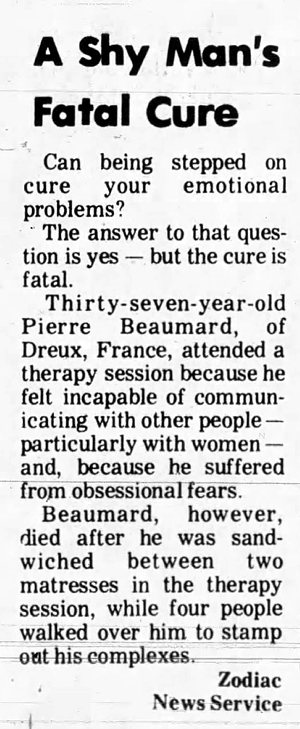
The Santa Clarita Signal - May 27, 1979

The Ottawa Citizen - May 17, 1979
Posted By: Alex - Sun Sep 05, 2021 -
Comments (2)
Category: Death, Psychology, 1970s
Crocodile Teasing at the Sriracha Tiger Zoo
The head in mouth bit comes after the four-minute mark.The Wikipedia page.
Posted By: Paul - Thu Aug 26, 2021 -
Comments (0)
Category: Animals, Death, Fairs, Amusement Parks, and Resorts, Asia
Please Kill Me
Unsolved after 20 years, and from what I can see, unsolved to the present day.Source for first clipping: Joplin Globe (Joplin, Missouri) 11 Nov 1948, Thu Page 4
Source for second clipping: The Emporia Gazette (Emporia, Kansas)17 Aug 1968, Sat Page 11
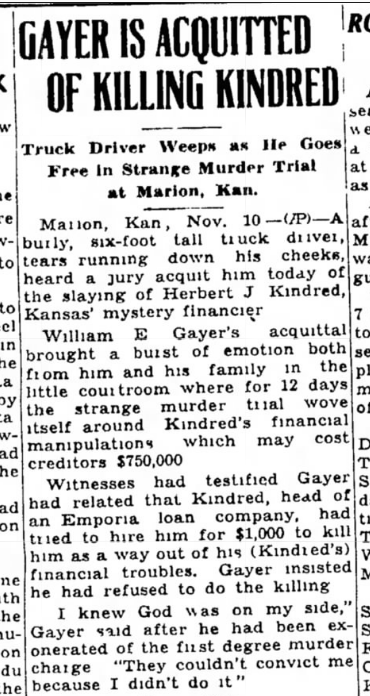
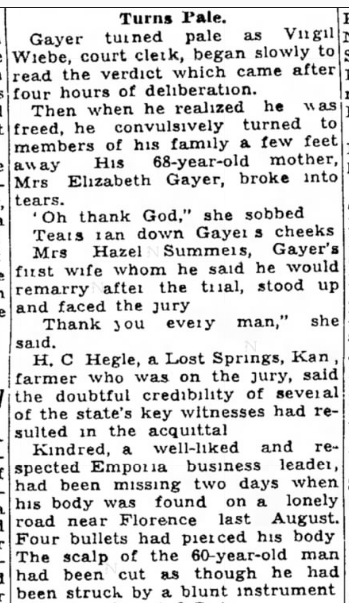
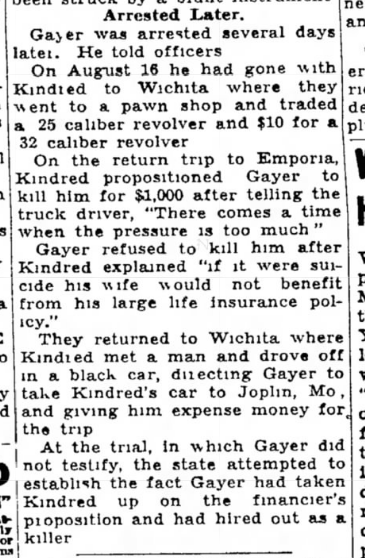
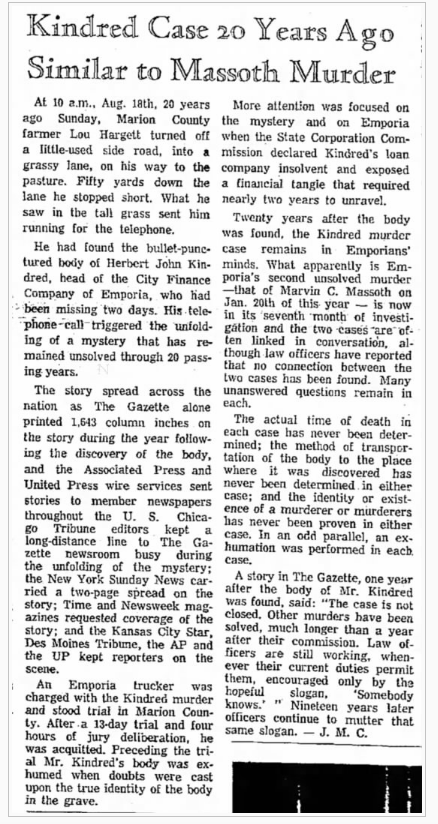
Posted By: Paul - Wed Aug 25, 2021 -
Comments (0)
Category: Death, Unsolved Mysteries, 1940s, North America
The Reid Flying Submarine
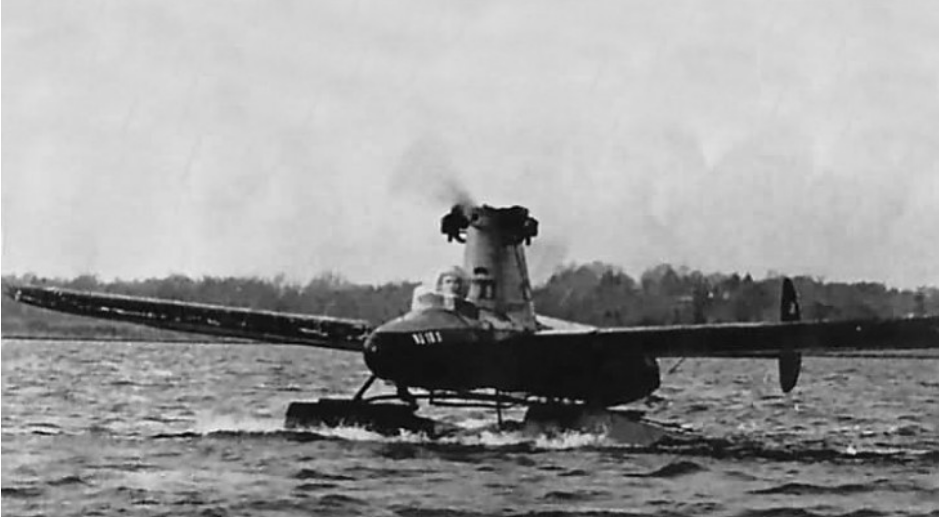
More pix and article here.
It wasn't a high-tech machine, despite its abilities. In the air it was powered by a 65 horsepower four-cylinder Lycoming engine. While underwater a 1-horsepower electric motor provided propulsion. Conversion from aircraft to submarine was a clumsy affair. The pilot first had to remove the propeller, and then cover the engine pylon with a rubber diving bell to keep the engine dry. The pilot used an aqualung to breathe. Maximum depth was roughly 10 to 12 ft (3.5 metres).
From THE SATURDAY EVENING POST for January 1, 1966.
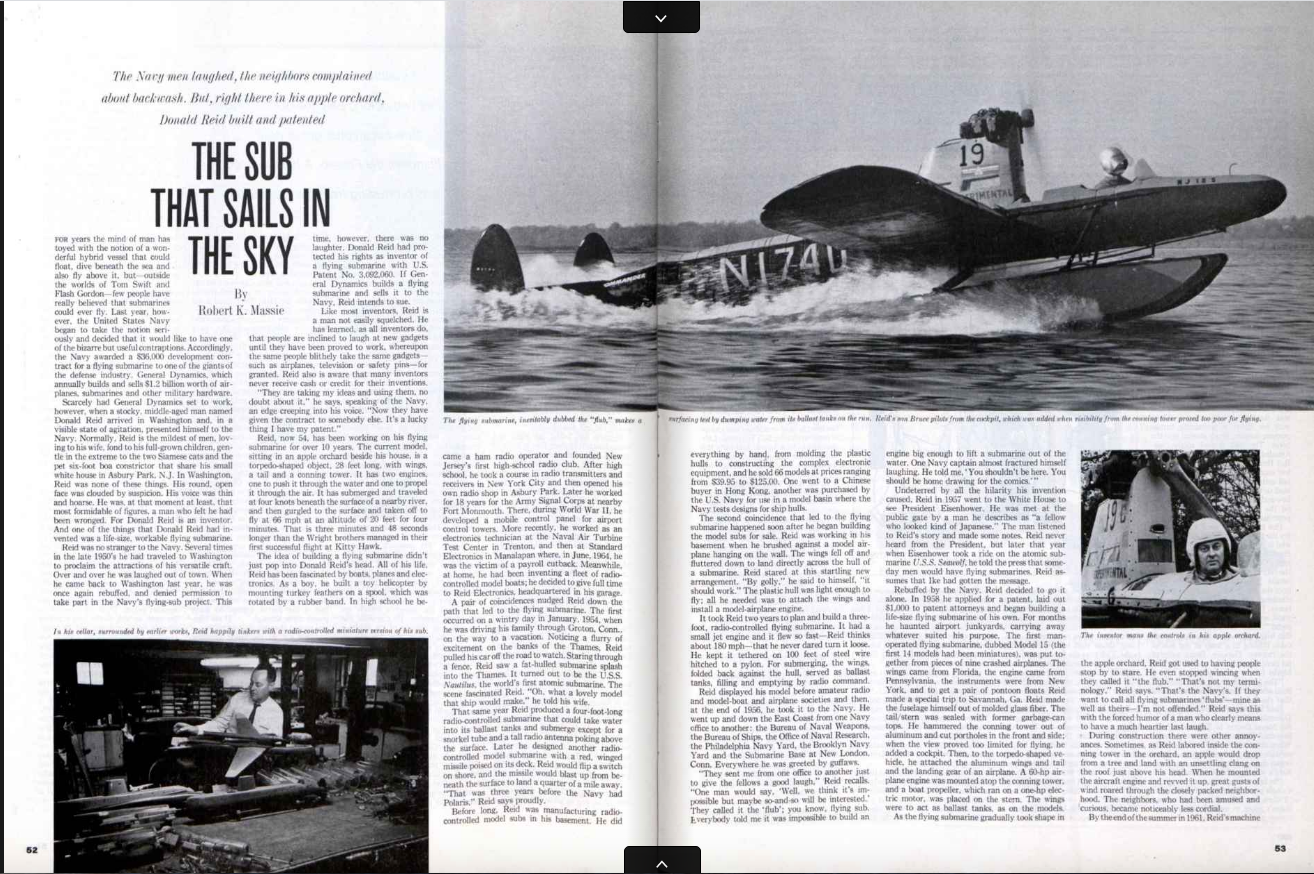
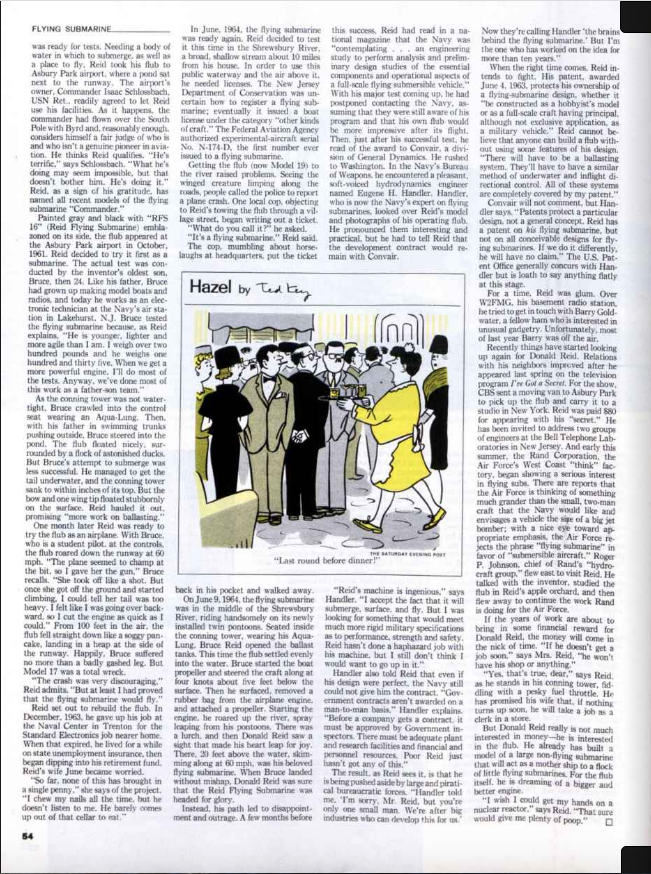
Posted By: Paul - Sat Aug 21, 2021 -
Comments (1)
Category: Death, Disasters, Inventions, Oceans and Maritime Pursuits, Air Travel and Airlines, 1960s
Unlikely Reasons for Murder No. 5
Suicide is self-murder, and offing oneself because your murderous insurance scam has come unraveled seems a bit more unlikely than accepting the punishment. Extra points given for swallowing poison in front of the cops. How did he have it so handy?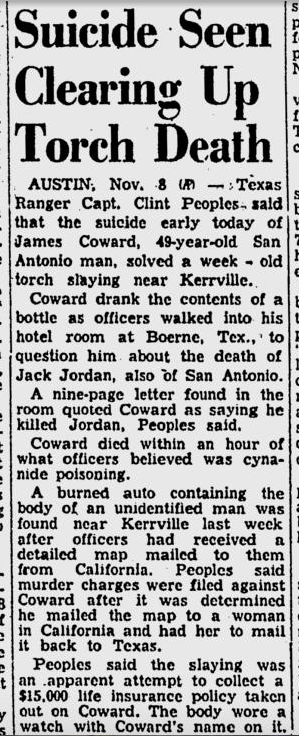
Source: The Daily Journal (Commerce, Texas) 09 Nov 1956, Fri Page 1
Posted By: Paul - Thu Aug 19, 2021 -
Comments (5)
Category: Death, Suicide, Scams, Cons, Rip-offs, and General Larceny, Stupid Criminals, 1950s
Pseudo Corpse Scent
The Sigma-Aldrich Corporation sells a variety of scents including: Pseudo Corpse I (that smells like a body less than 30 days old), Pseudo Corpse II (that mimics the dry-rot scent cadavers attain after a month), and Pseudo Drowned Victim.The scents are intended to be used for training rescue dogs, but I suppose they could also be used to enhance a Halloween costume.
Their product literature offers the following info about training dogs to find a corpse:
1 . Enthusiasm - the dog does not hesitate to approach the body. It may attempt to elicit a response from or urinate on the victim.
2. Cautious Interest - the dog slows its search, may become nervous and raise its hackles, but with encouragement, will approach the victim.
3. Avoidance - the dog will not approach the scent source and may actually attempt to leave the area. This behavior may become evident some distance from the body as the dog enters the scent cone.

image source: EliteK9.com
More info: Discover magazine
Posted By: Alex - Sat Jul 24, 2021 -
Comments (3)
Category: Death, Dogs, Perfume and Cologne and Other Scents
X-Radium Cooking Utensils
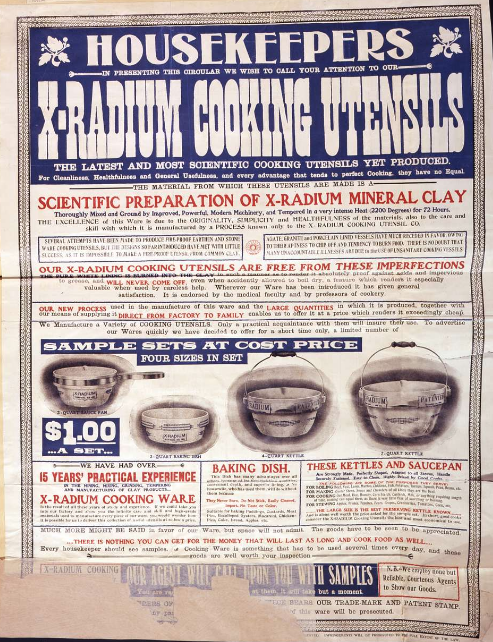
Here is a fascinating short monograph (a PDF) about the Radium craze, including a discussion of the product above.
Posted By: Paul - Mon Jul 19, 2021 -
Comments (6)
Category: Death, Domestic, Really Bad Ideas, Twentieth Century
The Resurrection of Gladys Rogers
When 80-year-old Gladys Rogers died of flu in 1978, her evangelist son decided that he would freeze her body and then bring her back to life with prayer. Her resurrection, he believed, would turn people to Christianity. She lay in an upright freezer as he prayed.
St. Joseph Gazette - Mar 13, 1978
He prayed for two months before conceding that he had failed. He attributed his failure to a lack of faith. "It had nothing to do with the power of the Lord," he said. "The main thing was I can't bring mama back, but I'll meet her again in Heaven."
More info: Springfield News-Leader

Miami Herald - Apr 1, 1978
Posted By: Alex - Fri Jul 09, 2021 -
Comments (2)
Category: Death, Religion, 1970s
Death by golf and peacocks
Oct 1951: Edward Harrison died in a freak golf accident, by managing to stab himself in the leg with a broken club. As he lay bleeding to death, he screamed for help. "Two other golfers said they twice heard screams, but thought they were the cries of peacocks from a peacock farm."
Deseret News - Oct 9, 1951
Posted By: Alex - Fri Jun 25, 2021 -
Comments (2)
Category: Death, Sports, Golf, 1950s
Death by playing cards
Oct 20, 1930: Convict William Kogut, who was waiting execution on San Quentin's death row, somehow knew that it was possible to make a bomb out of playing cards. This was because, at the time, the red ink of cards contained nitrocellulose. So by scraping off enough of the red ink, Kogut was able to make a pipe bomb out of a hollow bedpost. He used this to kill himself, rather than letting himself be executed.Modern playing cards no longer contain this explosive ingredient.
Somewhat confusingly, Snopes classifies his death as a "legend," even though their brief write-up seems to confirm that it happened exactly as described.
More info: theatrefx.com
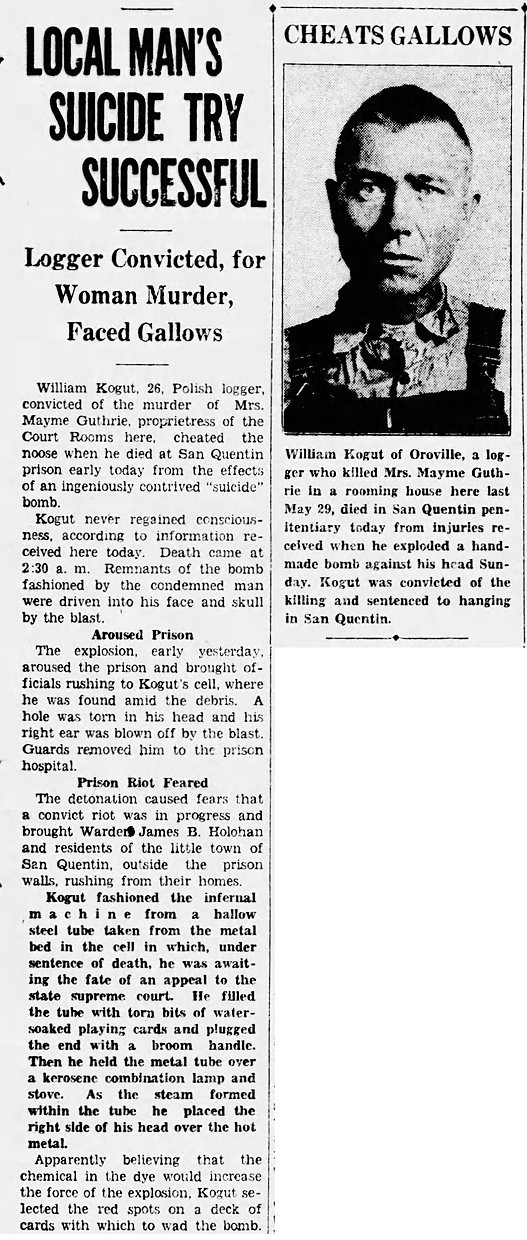
Oroville Mercury Register - Oct 20, 1930
Posted By: Alex - Wed Jun 23, 2021 -
Comments (3)
Category: Death, Suicide, Prisons, 1930s

| Who We Are |
|---|
| Alex Boese Alex is the creator and curator of the Museum of Hoaxes. He's also the author of various weird, non-fiction, science-themed books such as Elephants on Acid and Psychedelic Apes. Paul Di Filippo Paul has been paid to put weird ideas into fictional form for over thirty years, in his career as a noted science fiction writer. He has recently begun blogging on many curious topics with three fellow writers at The Inferior 4+1. Contact Us |




